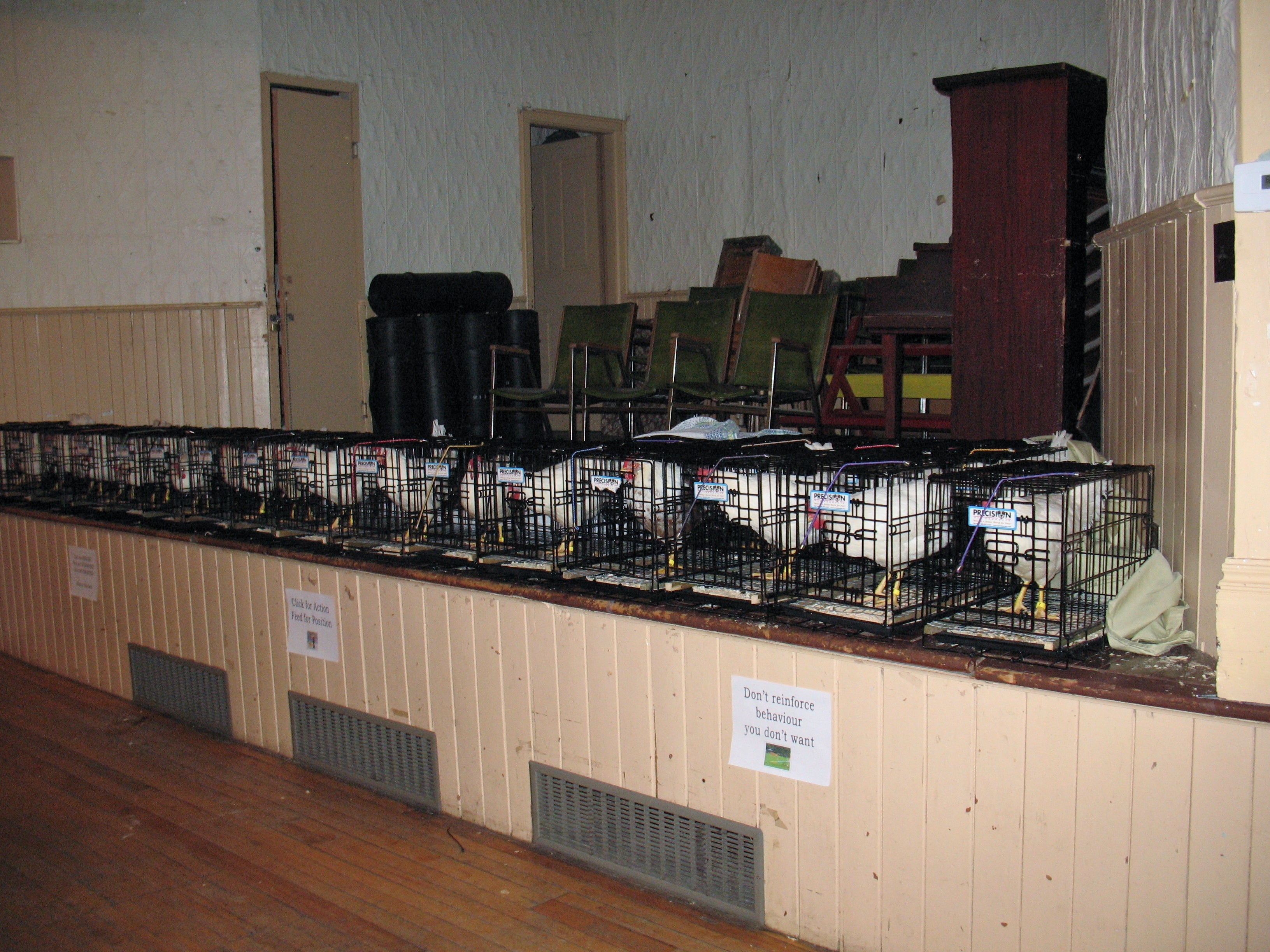
The first time I learned about chicken camp, I couldn’t believe what I was hearing. Train a what? Yes, train a chicken. I was intrigued. How could using clicker training for poultry possibly improve my dog-training skills? After all, isn’t a dog smarter than a chicken? Well, the point is not to win first place medals in the chicken obedience world championship. It’s about using chickens as a model for learning the theories and mechanics of animal training.
Training requires practice to become proficient, but most of us practice on our own dogs. Because of the emotional attachment we have to our pets, those feelings can get in the way of training, especially when things get challenging or we’re working toward a competition.
So, Why Train Chickens?
Unless you’re training your own pet chicken, chickens don’t come with any of that emotional baggage. You can hone your skills without worrying about the consequences. If your chicken doesn’t learn to walk around miniature pylons, she will be just fine.
Chickens are also unforgiving and don’t give second chances. If they don’t like how you’re training them, they simply freeze or fly off the table. You can’t force them or push them too hard. On the other hand, dogs want to work with humans and will put up with all kinds of unclear signals. It’s hard to notice training mistakes when the subject is so enthusiastically trying his best.
You might think chickens are stupid, but that’s not the case. They have a simple outlook on life, and their interest in you is strictly food-related, but they learn quickly. You can accomplish amazing things in a short amount of time and spot your weaknesses almost immediately. Chickens are also fast. The average chicken moves more quickly than the average dog, so you need impeccable timing to get the best results.

Off to Chicken Training Camp
When I heard about a chicken camp in my area, I signed up right away. I will confess, however, that I’m not comfortable around birds. I had to conquer my fear before enhancing my skills. Luckily, for the welfare of the chickens, we were given plenty of instruction on safe handling. I chose the largest chicken in the class because I thought she’d be easiest to catch and hold. I’m pleased to say that Bertha never bit me, although the chicken in the neighboring cage gently nipped whenever she got the chance.
Chicken campers work in pairs and take turns training their own chicken and coaching their partner. It was wonderful to have assistance with tasks like sweeping loose chicken food off the table or resetting the targets. More importantly, I had someone observing my behavior and body language and giving me immediate feedback about what I could improve. Good dog trainers provide the same type of coaching to their human clients.
I started with an easy job — feeding my chicken one pellet at a time from a metal cup. It seemed simple, but as I said, chickens are fast. I realized my timing was way too slow when my chicken would get multiple pellets before I pulled the cup away. Yet, if I was too quick, Bertha would get nothing. Timing during reward delivery is equally important when training a dog.
From Training Targeting to Fetch
Once I’d mastered reward delivery, I used shaping (training an animal to do something by waiting for him to offer a behavior) and a clicker to train my chicken to peck a target. At first, I rewarded a simple look toward the target (a paper circle), then, step-by-step, worked up to having her peck the direct center of the circle. If I clicked too early or too late, my chicken would think I was rewarding something else, such as taking a step or pecking the edge of the target, and her performance would diminish. But when I clicked at the exact right time, we had success. Dogs benefit from the same precision. To have that accuracy, it helps to stay focused and in the moment.
On the second day of camp, things got more complicated. I tried to teach my chicken to walk in a figure eight around small pylons. This really brought home the importance of reward placement. Rather than stalling the behavior in one place, I could encourage my chicken to continue walking around the pylons by placing the food cup ahead of her. Reward placement can be equally valuable with dogs.
I also came to appreciate the value of a high rate of reinforcement (how often you give rewards). Without frequent rewards, a chicken will lose interest, so I needed to keep my expectations at the right level: low enough so that Bertha would be rewarded regularly and often, yet high enough so that she would continue to improve. As with dogs, you can’t expect too much too soon. Plan your training sessions to set your dog up for success.
My favorite trick involved teaching Bertha to fetch a tiny stuffed animal. She didn’t bring the toy back to my hand, but if we’d had another few sessions — and I had better skills — she probably would have been fetching like a Labrador Retriever. I learned the value of breaking down a complex behavior into a series of much smaller ones, and to be flexible when moving through the steps. You never know when your dog is going to outperform your expectations, so you must be ready to jump ahead in your plan, if necessary.
If you’re looking for a way to enhance your mechanical training skills or learn more about the power of operant conditioning (the science behind positive dog training), consider attending a chicken camp. You’ll be amazed at what you can teach them — and what they will teach you!

